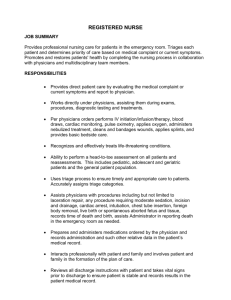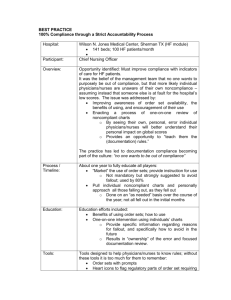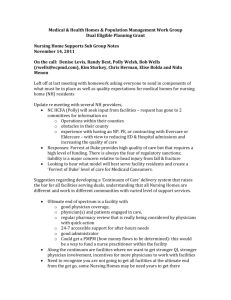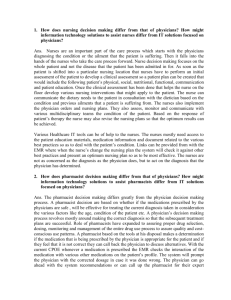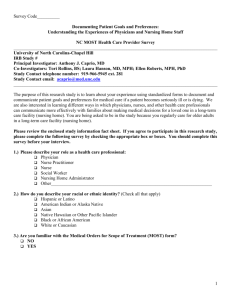Nursing/Physician Shortage`s and Impact on Marketing with the
advertisement
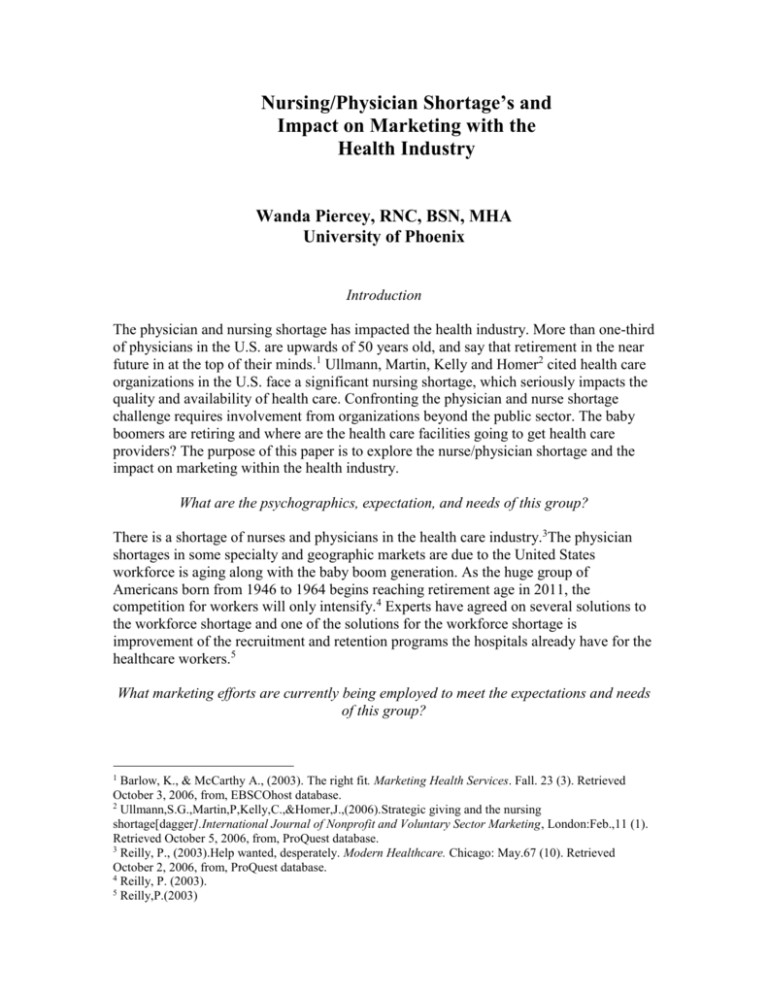
Nursing/Physician Shortage’s and Impact on Marketing with the Health Industry Wanda Piercey, RNC, BSN, MHA University of Phoenix Introduction The physician and nursing shortage has impacted the health industry. More than one-third of physicians in the U.S. are upwards of 50 years old, and say that retirement in the near future in at the top of their minds.1 Ullmann, Martin, Kelly and Homer2 cited health care organizations in the U.S. face a significant nursing shortage, which seriously impacts the quality and availability of health care. Confronting the physician and nurse shortage challenge requires involvement from organizations beyond the public sector. The baby boomers are retiring and where are the health care facilities going to get health care providers? The purpose of this paper is to explore the nurse/physician shortage and the impact on marketing within the health industry. What are the psychographics, expectation, and needs of this group? There is a shortage of nurses and physicians in the health care industry.3The physician shortages in some specialty and geographic markets are due to the United States workforce is aging along with the baby boom generation. As the huge group of Americans born from 1946 to 1964 begins reaching retirement age in 2011, the competition for workers will only intensify.4 Experts have agreed on several solutions to the workforce shortage and one of the solutions for the workforce shortage is improvement of the recruitment and retention programs the hospitals already have for the healthcare workers.5 What marketing efforts are currently being employed to meet the expectations and needs of this group? 1 Barlow, K., & McCarthy A., (2003). The right fit. Marketing Health Services. Fall. 23 (3). Retrieved October 3, 2006, from, EBSCOhost database. 2 Ullmann,S.G.,Martin,P,Kelly,C.,&Homer,J.,(2006).Strategic giving and the nursing shortage[dagger].International Journal of Nonprofit and Voluntary Sector Marketing, London:Feb.,11 (1). Retrieved October 5, 2006, from, ProQuest database. 3 Reilly, P., (2003).Help wanted, desperately. Modern Healthcare. Chicago: May.67 (10). Retrieved October 2, 2006, from, ProQuest database. 4 Reilly, P. (2003). 5 Reilly,P.(2003) One of the marketing efforts of recruiting and retaining nurses and physicians is the Magnet Strategy.6 Magnet strategies are not new to the healthcare industry because the terminology and concept has been traced as far back as 1983 when the American Academy of Nursing first used the term “magnet hospital” to describe 41 facilities that had become known for the facilities ability to attract and retain nurses despite the significant nursing shortage during the 1980s.7 Magnet strategies focus on personnel culture that supports professionalism throughout all areas of the hospital. An example of the magnet strategy was used by the chief executive officer Mary G. Nash, PhD., CHE, FANN of the University of Alabama Hospital in Birmingham. Dr. Nash enhanced UAB’s recruitment and retention of physicians and nurses by earning the magnet designation which was a natural extension of the standards of service excellence to which hospitals have long been committed.8 Dr. Nash of UAB also indicated that magnet status was not all that was needed to retain hospital service excellence because UAB also used benchmarks to set staffing standards. UAB used the national benchmarks to ser standards for each area in the hospital. The facility holds managers accountable for staff dollars and hours. One of UAB’s recruitment and retention of nurses and physicians is to also avoid using agency staffing while avoiding mandating overtime. A marketing strategy the Ohio Board of Nursing has of recruiting nurses to the nursing schools is to give “Nursing Rewards”. 9 Ohio has the Nursing Education Grant program which will have $10 million in grants to potential nursing students. The grant monies will be available for over 10 years to the Ohio nursing education programs. What other marketing efforts could be successful in reaching this group? Kennedy introduced a new marketing strategy to assist in the recruitment of physicians and nursing personnel because many health care organizations are experiencing a shortage.10 Kennedy proposed the establishment of an agency that would become a “quality council”.11 The quality council agency would pertain to the marketing concept of a shift in thinking of how and where healthcare providers are needed. He indicated the need for a shift in thinking or one needs to think on a national co-operation to bypass some of the bureaucracy or some of the competition. 6 Pieper, S.K., (2003). Retaining staff the magnet way: Fostering a culture of professional excellence. Healthcare Executive. Chicago: May/Jun. 18 (3). Retrieved October 2, 2006, from ProQuest database. 7 Pieper, S.K. (2003). 8 Pieper, S.K., (2003). 9 PR Newswire, (2003). Statewide campaign launched by Ohio board of nursing to address nursing shortage. New York: Nov. Retrieved October 2, 2006, from, ProQuest database. 10 Kennedy, M., (2002). Health staffing agency proposal; [Final Edition].Calgary Herald. Calgary, Alta: Oct. Retrieved October 2, 2006, from, ProQuest database. 11 Kennedy, M., (2002). Sabationo introduced the marketing concept of diversification.12 Healthcare organization, according to Sabationo has a need to cater more to culture diversity when obtaining physicians and nurses. According to government statistics, in 1991, minorities constituted 22% of the US population only 8% of practicing physicians and 14.2% of nursing school enrollments.13 Culture diversity challenges the health care field to make better use of a radically changing labor force. Physicians can now market themselves and their practices to the 2.5 million individuals that visit HealthGrades.com each month to research the quality and credentials of physicians.14 This program enables physicians to increase the visibility of their reports throughout the Health Grades website and to increase the likelihood that their reports are ready by eliminating the $7.95 fee that Health Grade currently charges consumers for each report. The Health Grade website has over 600,000 physicians that cover more than 100 specialties and subspecialties. The website enables physician to advertise to the consumer plus the website allows the consumer to make smarter choices when choosing a physician. Is targeting this population financially viable for most health organizations? Targeting the physician and nurses recruitment strategies for health care organizations is a must for the health care industry. More than one-third of physicians in the U.S. are upwards 50 years old, and many physicians say that retirement in the near future is at the top of their minds.15 This analogy has health care organization fixed on combating the repercussions. Nearly 90% of hospitals are actively recruiting physicians and according to the surveys that were conducted by Barlow and McCarthy, recruiting and retaining physicians is a strategic issue and at the center of the health care organizations growth.16 Health care executives have to recruit physicians and nurses to be proactive rather than reactive in the health care industry.17 The survey indicated that marketing executives are pigeonholed as only having the ability to affect business with a promotional strategy and not the entire marketing mix. Hospitals and systems that understand the role of marketing and business development see them as one and the same and reap the benefits.18 Almost all healthcare organizations in the U.S. continue to operate in competitive environments, strategic positioning is a concept that warrants careful consideration.19 12 Sabatino, F., (1993). Culture shock: Are U.S. hospitals ready? Hospitals Chicago: May. 67 (10). Retrieved October 2, 2006, from, ProQuest database. 13 Sabatino, F., (1993). 14 Business Wire, (2005). Health Grades enhances physician quality reports for consumers: doctors’ own profiles and patient satisfaction surveys added to education, training, sanction information and more. Business Wire. New York: Aug. Retrieved October 2, 2006, from, ProQuest database. 15 Barlow, K., & McCarthy A., (2003). 16 Barlow, K., & McCarthy, A., (2003). 17 Jensen, J., (2004). Evolving roles. Marketing Health Services. Summer, 24 (2). Retrieved October 2, 2006, from, EBSCOhost database. 18 Jensen, J., (2004). 19 Gershon, H.J., (2003). Strategic positioning: Where does your organization stand? Journal of Healthcare Management. Chicago: Nov/Dec. 48 (1). Retrieved August 10, 2006, from, ProQuest database. Targeting physicians and nurses for recruitment and retention would definitely be financially viable for health care organizations. How would an organization have to change its marketing strategy to target this population, if at all? Healthcare organizations need to change their marketing strategy used to recruit and retain nurses and physicians by building and publicizing clinical indicators of being the employer of choice.20 A marketing strategy that was a short-term solution for recruiting physicians and nurses to health care organizations would be to offer financial incentives.21 The first step in market management is to define the specific market or market segment being considered.22 The marketing strategy to target recruitment of physicians and nurses could be accomplished in several ways. The ways of recruitment are (1) better matching of customer needs, (2) enhancing profitability through targeted offerings, and (3) retaining customers through the development of ongoing relationships.23 The Washington Metro and New York subways are plastered with advertisement for health plans and health services.24 The marketing strategy in Washington and New York is bright signs of advertising in areas such as subways where the most population can view and read the advertisement is a way of marketing health plans and health services. The seven tips offered for creating a position strategy plan for health care organization: (1) do not copy another organization’s plan (1) tie marketing strategies to the overall strategic plan (3) stay true to the organization’s mission (4) pay attention to communication (5) put the organization’s leaders in the spotlight (6) know the organization’s abilities and limits and (7) encourage everyone in the health car organization to sing from the same hymnal.25 When marketing to this population, are other populations naturally excluded? All health care organizations have to address staffing issues of nurse and physician shortages by forecasting the health car needs of the community and potential expansion of the health care facility. The health care facility will have to identify resources to 20 Pieper, S.K., (2003). Hillard, W., (2002). Panel hears doctor recruitment tips: [Final Edition]. Telegram St. John’s Nfld.: Sep. Retrieved October 2, 2006, from, ProQuest database. 22 Gershon, H.J., (2003). Market management: A concept worth exploring. Journal of Healthcare management .Chicago: Nov/Dec. 48 (1). Retrieved August 10, 2006, from, ProQuest database. 23 Gershon, H.J., (2003). 24 Timmins, N., (2006). Hospitals move down the path of hard sell MARKETING STRATEGY: Rival health services are preparing to engage in big media campaigns aimed directly at patients, writes Nicolas Timmins; [London 1st Edition]. Financial Times. London (UK). Feb. Retrieved October 2, 2006, from, ProQuest database. 25 Meyers, J.Z., & Weise, S., (2006). Marketing for the rural care provider. Health Care Wipfli Accountants & Advisors. Retrieved August 29, 2006, from, http://www.wipfli/Impact_Magazine/Industry_archive/Health_Care/General/200608HC_Rura;Health_Care-Mar… 21 support new marketing initiatives for the procurement of additional staff of health care providers. Marketing strategies for recruiting physicians and nurses for the rural community is to help a person of the rural community grow up and move back to the rural community.26 Another innovative marketing idea is to encourage young people to enter the medical profession from the rural community and give financial aid. Urbanites potentially have difficulties adapting to rural life which is another marketing strategy to encourage the young people of the rural community to enter the medical profession and return to his or her rural community. Mary-Anne Cooke currently holds the position of “head of business department” for a group of hospitals which are experiencing problems with obtaining sufficient staffing of physicians and nursing personnel. One of the innovative ways Mary-Anne has of reaching potential physicians and nurses in Internet marketing.27 Mary-Anne knows patients have choices as to where they want to be treated and hospitals are paid by the number of patients that are treated so if the hospital is experiencing problems with staffing the hospital with suffer economical loss and decreased revenue. Mary-Anne’s Internet marketing strategy has improved physician and nurse recruitment for her group of hospitals. Conclusion Physician/nurse shortage has greatly impacted health care organizations. One has to only look at the want ads in any local newspaper and see the marketing strategies used by the various health care facilities to understand this problem of the physician/nurse shortages. The problem is not only a local problem but the problem is of a national level also. The baby boomers are retiring and health care facilities will truly be challenged to come up with new marketing strategies for recruitment of physicians and nurses to provide the health care services to the consumer. Staffing issues are one of the reasons people are being discharged from hospitals sooner and coming into the hospital sicker. Hilliard, W., (2002). Panel hears doctor recruitment tips: [Final Edition]. Telegram St. John’s Nfld.: Sep. Retrieved October 2, 2006, from, ProQuest database. 27 Timmins, N., (2006). 26

